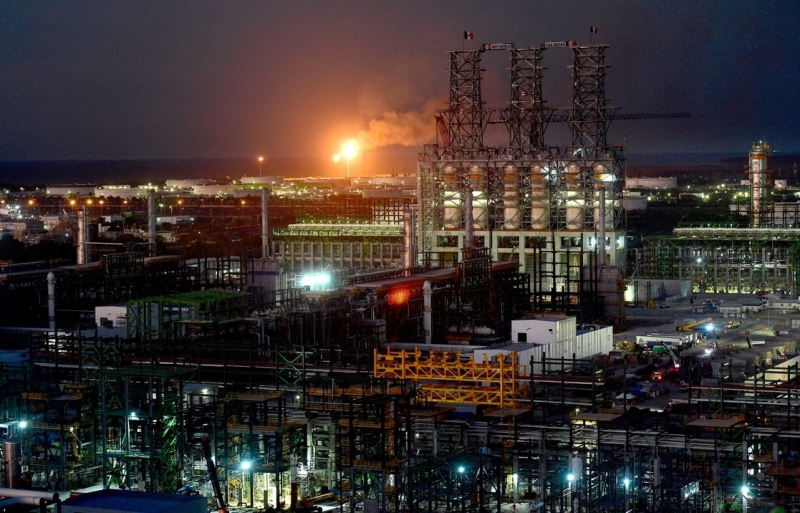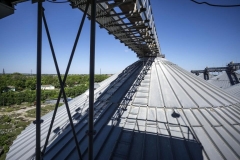Mexico opens Refinery
Next to the Sonda de Campeche, where 80 percent of crude oil is produced in Mexico, the Olmeca-Dos Bocas Refinery will be inaugurated this Friday, which for its construction required an amount of steel equivalent to 16 times the Eiffel Tower -symbol of the French capital–, or concrete with which the Azteca stadium could be raised 41 times.
The flagship project of the government of President Andrés Manuel López Obrador seeks to reduce the country's energy dependence and achieve self-sufficiency in the production of gasoline and diesel to "offer better prices for these fuels to consumers."
It will process 340,000 barrels of Maya-type crude oil per day, of which 170,000 will be gasoline and 120,000 diesel. Although said production will be reached until 2023.
"The plan is to produce more gasoline in our country, modernizing the six refineries and building a new one to reduce the cost of fuel," the Secretary of Energy (Sener) said in 2019 when announcing the work that is located on 566 hectares of a estuary located in the Tabasco municipality of Paraíso.
The federal government chose the port of Dos Bocas because the oil pipelines from the Tabasco coast and the Sonda de Campeche arrive there, where 80 percent of hydrocarbons in Mexico are extracted.
From its location it will go up by sea to the ports of Tuxpan, Veracruz, Pajaritos and Progreso, but it will also connect to the National Network of Polyducts to distribute at the junction with Minatitlán, through 35 kilometers of pipelines.
Other objectives of the project, which “represents a change in the energy paradigm”, is to “maximize economic and social benefit and trigger development in the Southeast”, where three of the four flagship projects of the current administration are located.
The industrial plant will process the crude extracted by Petróleos Mexicanos (Pemex), that is, it distills the oil to obtain gasoline, diesel, jet fuel and kerosene, among other products considered "refined with higher added value."
Although it was projected as the seventh refinery of the state company, it will be the eighth, since last year the federal government acquired Deer Park from Shell, a plant located in Texas, United States. But it will be the first to be built in the country since 1979, since the previous one was Salina Cruz, in Oaxaca.
When the project was announced in 2019, the federal government indicated that it would cost 8 billion dollars, but in recent days President López Obrador acknowledged that the cost rose to almost 12 billion dollars.
For the construction of the work, tenders were divided into six packages. Fluor Entrerprises and ICA Fluor were responsible for the combined plant and the coking plant, while Samsung Engineering and Asociados Constructores DBNR carried out the catalytic cracking plant, alkylation and an isomerizer.
Kellogg Brown & Root and Constructora Hostotipaquilo were chosen to build the bitter water plant, the gas treatment plant, the sulfur recovery plant and the hydrogen production plant.
Kellogg Brown & Root, Constructora Hostotipaquilo and Mexicana de Recipientes a Presión were entrusted with integration services. Although it should be noted that Kellogg Brown & Root left the project in 2020 and ICA Fluor entered as a replacement.
According to Sener, the work required more than one million 745 thousand cubic meters of concrete, which is equivalent to what would be needed to build the Azteca Stadium 41 times. In addition, 162 thousand tons of structural steel were used, a volume of material with which 16 Eiffel towers could be built.
Until May, the authorities reported that the construction of this Pemex plant has generated 32,000 direct jobs and more than 200,000 indirect jobs.
The Olmeca-Dos Bocas Refinery will have more than 90,000 pieces of equipment. The facilities consist of 17 processing plants, a storage area where 92 tanks are located, of which 58 are for gasoline and diesel.
In the remaining 34, which translates into 680 thousand barrels of installed capacity, light components will be stored, such as butanes, isomers and propylene, among others, which will serve as an intermediate balance during the crude oil process.
It will also have four cooling towers, whose cells cool 788 liters per second. This equipment is used to remove heat from the petrochemical process, cooling the water with an air current so that it can be reused.
Elle disposera d'un système de cogénération électrique dans le but de rendre une raffinerie autonome dans ses services, ainsi que des ateliers, des salles de contrôle et des bâtiments administratifs.
Mise en marche
Ce 1er juillet, une phase de test sera lancée d'une durée de six mois, c'est-à-dire qu'en 2023 elle commencerait son exploitation.
Ramsés Pech, spécialiste du secteur de l'énergie, a commenté que pendant la période de test, qui peut durer jusqu'à 8 mois, l'herméticité de chaque équipement, lignes en termes de pression et de débits, le bon fonctionnement des installations en termes de conditions de température, de réactions ou de pressions pour le processus auquel ils ont été réalisés. "C'est-à-dire mettre du pétrole brut et observer de l'entrée à la sortie que tout fonctionne", a-t-il dit.
Il a précisé qu'il est "très difficile pour les raffineries de travailler à 100%" de leur capacité, puisque les pourcentages oscillent généralement entre 85 et 93%.
Cependant, en raison de problèmes de test et de certification - donnés par un tiers qualifié -, il peut atteindre cette production.
L'expert a estimé que le Mexique atteindrait l'autosuffisance énergétique si Pemex produisait 2 500 000 barils de pétrole brut par jour et envoyait 1 600 000 barils aux raffineries, qui doivent exploiter au moins 84 %, en plus d'Olmeca et Deer Park envoyer tout le volume de production .
Quelques heures après l'inauguration des installations, la Commission de régulation de l'énergie a approuvé un permis E/2268/GEN/2022 permettant à Pemex Transformación Industrial de produire de l'électricité dans la raffinerie, qui a été construite en moins de trois ans.
campeche, dos bocas, raffinerie, première phase, inauguration, amlo, lopez obrador

Comments to this:








